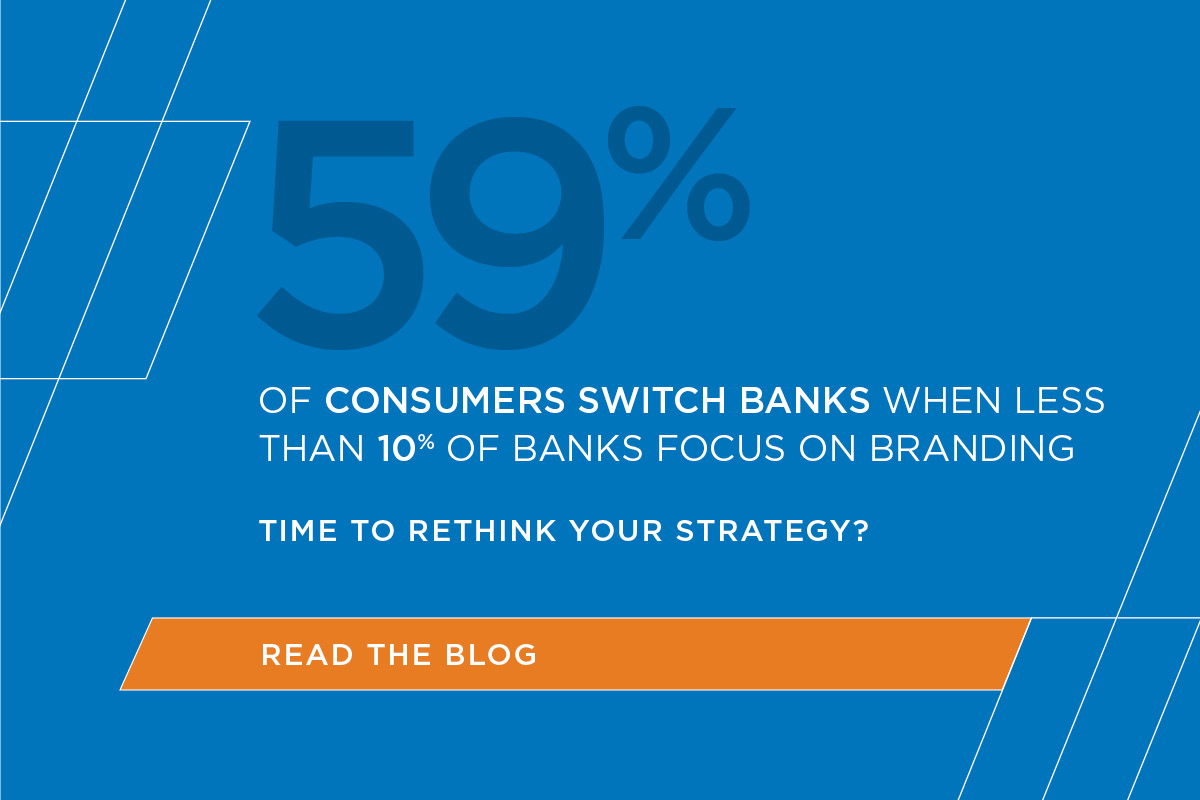The pressure to deliver immediate results has led many marketers to focus on short-term activation strategies and less on brand building. Balancing short-term activation with long-term brand investment is crucial for lasting success. Bank marketers must start depositing in the emotional piggy bank of customers through always-on brand messaging.
A recent study conducted by Accenture found that 59% of consumers recently acquired a bank product from another provider instead of their primary financial institution.1 This lack of loyalty could be due to bank marketers over-investing in short-term product promotion messaging, forgoing investment in consistent brand building. Are we further commoditizing ourselves like the corner gas station by only flashing our latest price?
According to Gartner, 65% of marketers believe a brand is a critical driver of buyer behavior, yet most bank advertisements are product promotion pushing rates, incentives and a litany of other tactics that are impersonal and don’t lead to trust.2 There seems to be a disconnect between what marketers say and how they deploy their marketing budgets.
Short-Term Activation: The Sugar High
Marketers have become fixated on the benefits of short-term activation. Studies in retail banking show that short-term promotions and discount campaigns may have a positive, immediate effect on the numbers. However, these effects are often fleeting, leading to a decrease in brand trust. When people are flooded with an excess of offers, it dilutes their perception of value. It’s understandable that people can feel overwhelmed by the abundance of marketing messages that offer incentives.
Advertising budgets in the financial sector are almost exclusively product promotion. Financial services exhibit the most considerable under-allocation of investment in brand building. Vericast examined the year-over-year investment of brand vs product promotion from 2018 to 2022 through Mintel. The data reveals a stark imbalance, with more than 90% funneled into product promotion and less than 10% invested in brand messaging.3 This strategy stands in stark contrast to the model proposed by Les Binet and Peter Field’s research on long-term marketing value and effectiveness. Their studies suggest that for financial services, it’s more beneficial to flip this allocation, directing 80% of the investment to branding and a mere 20% to product promotion.4 This would represent a drastic change in mindset for bank marketers and I don’t believe swinging the pendulum that far in the other direction would be a good idea. Everything in moderation and balance is the key to moving forward.
The Benefits of Balancing Short-Term Activation with Long-Term Investment
People are drawn to brands that offer both short-term benefits and long-term value. In the realm of retail banking, striking a balance between short-term activation and long-term brand investment is pivotal. While short-term activations induce immediate results and an apparent return on investment, long-term brand investments fortify the foundation of trust and loyalty with consumers over time. The more competitive and mature a sector like financial services is, the more vital it is that we harness the priming effects of emotional (brand) advertising with product promotion. Bank marketers would get more out of product promotion if they would invest in long-term brand efforts.
Measuring the ROI of Long-Term Investment
Measuring the return on investment for long-term brand investment can be difficult because the benefits are not always immediate. Strong brands win in good and bad times.
Another study from Gartner also found that investing in brand building can help banks increase their market share by up to 8%.5
This serves to emphasize the importance of investing in brand building and creating an experience that customers trust. Banks should therefore strive to build a strong brand identity that reflects the values they hold and resonates with consumers. A successful brand will ultimately lead to greater customer satisfaction, better returns from product promotion messaging and long-term profitability for the bank.
Achieving Long-Term Success
By adopting a balanced approach, brands can combine short-term activation tactics with a focus on long-term brand building. This means allocating resources to activities that enhance brand reputation, improve customer experiences, and strengthen brand awareness. Investments in consumer banking branding may not yield immediate returns, but they lay a solid foundation for sustainable growth and customer loyalty in the future. Unlike short-term promotions that often lead to a temporary surge in customer behavior, a well-established brand fosters a lasting relationship with its consumers.
The decision to invest in brand building often boils down to the company’s financial health, marketing objectives and competitive landscape. CMOs are likely to acknowledge the long-term value and vital role of brand building but CFOs may be more inclined to push the organization toward product promotion that solves for the more immediate need to drive revenue. This may often lead to an internal dilemma between prioritizing short-term gains or long-term success.
Smart brands tend to recognize the symbiotic relationship between brand building and product promotion. In the realm of consumer banking, an “always-on” brand campaign allows companies to establish a strong, enduring brand presence, fostering deeper connections with customers. Fortunately, brand building is more affordable today than in the past thanks to the expansion of digital channels. By implementing an omnipresent branding strategy, where the brand is consistently visible across various touchpoints, financial institutions can reinforce their identity and create a lasting impression on consumers.
The Takeaway
Having an omnipresent branding strategy combined with well-timed bursts of product promotion messaging can significantly enhance customer activation and the overall effectiveness of campaigns. The power of branding in consumer banking should not be underestimated.
Get real-time insights to make better, more informed marketing decisions
1 Accenture, Global Banking Consumer Study, March 2023, n=176
2 Gartner, Marketers’ Guide to B2C Brand Strategy, October 2020
3 Mintel, Compermedia, July 2023
4 Marketing Week, This Much I Learned: Les Binet and Peter Field on 10 Years of The Long and the Short of It, March 2023
5 Gartner, Brand Survey 2019: Marketers Believe in the Power of Brand but Struggle to Respond to Disruption, 2019, n=393
